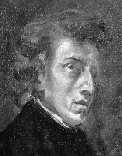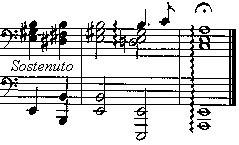Harmony: functional and dysfunctional
by Professor Wilfrid Mellers
Part III A: Two cosmopolitan romantics:
Chopin, Poland, and Paris; Liszt, Hungary, and Europe.
Although Schubert, Schumann and Brahms belonged to the central Austro-German
tradition in 19th century music, it is predictable that the two most extreme
early romanticists should have been outsiders. Chopin came from remotely
'barbaric' Poland but, belonging to the ruling class, was highly sophisticated,
trilingually reared on French literature and Italian opera. In part a political
exile from his native land, he lived in fashionable Paris, creating virtuoso
piano music retrospective of his childhood, and at the same time prophetic
of visionary futures. He didn't entirely eschew the classical sonata, but
totally transformed it: especially in the Second Piano Sonata in the grimly
'Russian' key of B flat minor: which opens with a 'motto theme' that , as
with Schumann's piano cycles, functions rather like the principle of variation,
appearing in each movement. The first allegro transforms sonata-duality
into a nightmare ride derived from the movements of the fingers over the
keyboard, with a yearningly lyrical second subject straight from Italian
opera. The scherzo teeters between frivolity and fright in a giddy Parisian
valse; while the slow movement is a funeral march in the style of Polish
folk-lament, the motto theme appearing only retrospectively, in the spectral
trio. In the extraordinary finale melodic line iteself becomes harmonic
disintegration, for the brief piece is in unison throughout, yet its effect
is entirely harmonic. Intermittently, tonality disappears; the music becomes
a fluttering of the nerves telling us, in an intimate whisper, what Wagner's
Tristan will utter in grandly impassioned rhetoric: that the battle
between man and God, or between man and the world, has been absorbed into
the inner life of a single hyper-sensitive soul.
Fryderyk Chopin
(1810 - 1849)
Piano Sonata no.2
- Finale.

|
 |
This extra-ordinary moment in 19th century music helps us to understand
why Chopin mostly used relatively short, 'momentary' forms. His most impressive
larger works are the four Ballades, which re-create sonata form in terms
that are psychological and occasionally narrative; but the bulk of his piano
music uses forms based on song and dance, whether they be mazurkas and polonaises
in folk styles recalled from his childhood, or gleanings from the glamour
of the Italian opera house and Parisian ballroom. The most surprisingly,
even alarmingly, innovative of his short pieces are related to his virtuosity
at a keyboard, especially in the two sets of Etudes, opus 10 and opus 25:
as is palpable in the famous E major Etude from opus 10, wherein a seductively
harmonized Italianate love-song literally dissolves in chromatic fioriture
that surrender any sense of a tonal centre:
The Chopin E major Etude from op.10,
played by Adrian Williams. |
 |
The Preludes, opus 28, although seldom deliberate exercises in virtuosity,
are short, sometimes very short, pieces that, in being 'moments' of sensation,
often threaten traditional formalities: the tiny A minor Prelude, for instance,
based on Polish lament rather than Italian opera, does not establish its
key until its two final bars, which reverberate like a death-knell.
The Chopin A minor Prelude, op.28 no. 2.

|
 |
Copyright © 1999 Wilfrid Mellers
Continue >>
|